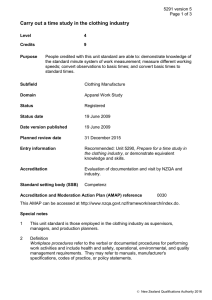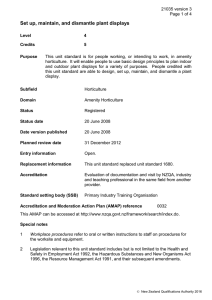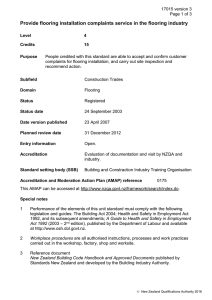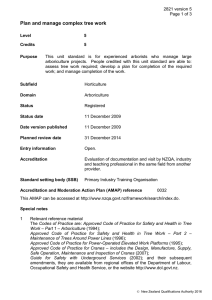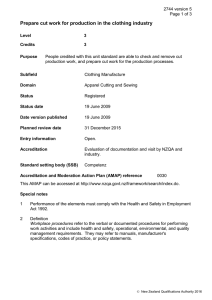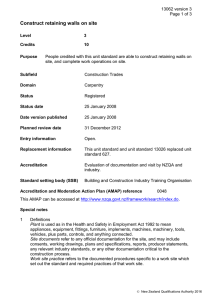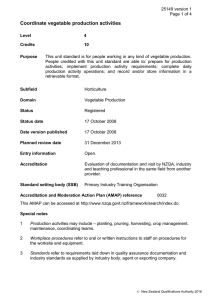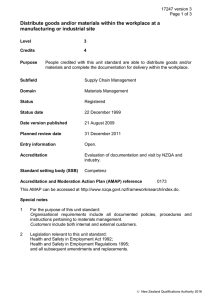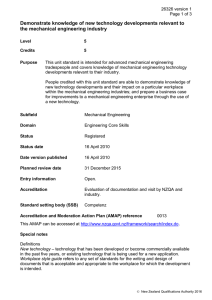Establish and maintain plant collections
advertisement
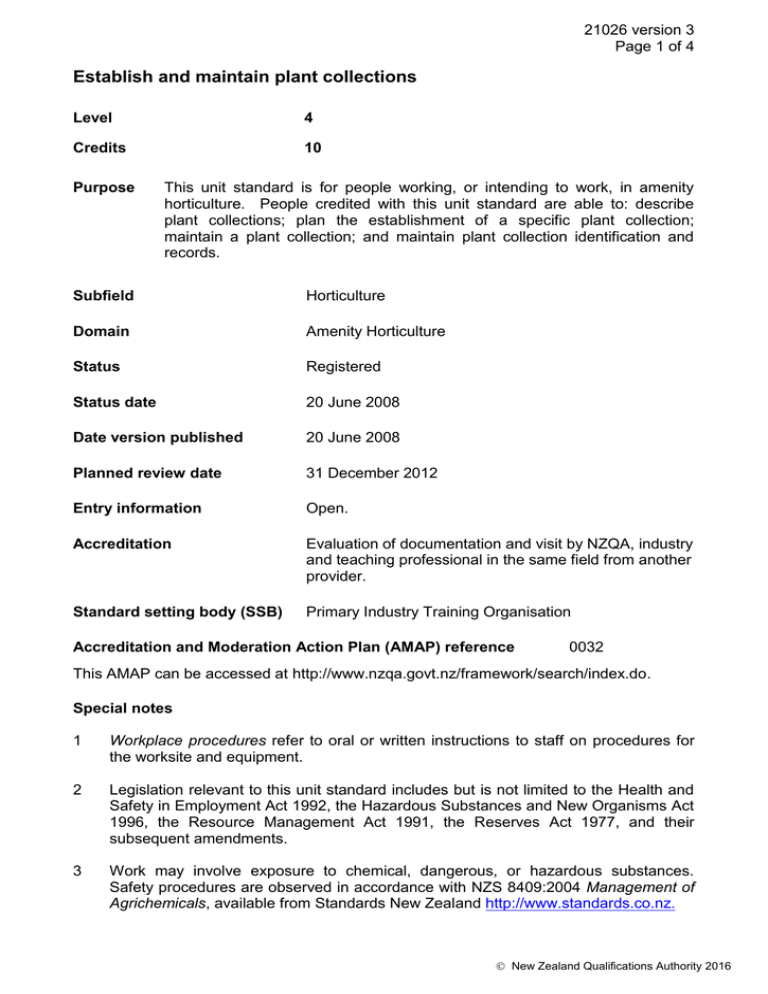
21026 version 3
Page 1 of 4
Establish and maintain plant collections
Level
4
Credits
10
Purpose
This unit standard is for people working, or intending to work, in amenity
horticulture. People credited with this unit standard are able to: describe
plant collections; plan the establishment of a specific plant collection;
maintain a plant collection; and maintain plant collection identification and
records.
Subfield
Horticulture
Domain
Amenity Horticulture
Status
Registered
Status date
20 June 2008
Date version published
20 June 2008
Planned review date
31 December 2012
Entry information
Open.
Accreditation
Evaluation of documentation and visit by NZQA, industry
and teaching professional in the same field from another
provider.
Standard setting body (SSB)
Primary Industry Training Organisation
Accreditation and Moderation Action Plan (AMAP) reference
0032
This AMAP can be accessed at http://www.nzqa.govt.nz/framework/search/index.do.
Special notes
1
Workplace procedures refer to oral or written instructions to staff on procedures for
the worksite and equipment.
2
Legislation relevant to this unit standard includes but is not limited to the Health and
Safety in Employment Act 1992, the Hazardous Substances and New Organisms Act
1996, the Resource Management Act 1991, the Reserves Act 1977, and their
subsequent amendments.
3
Work may involve exposure to chemical, dangerous, or hazardous substances.
Safety procedures are observed in accordance with NZS 8409:2004 Management of
Agrichemicals, available from Standards New Zealand http://www.standards.co.nz.
New Zealand Qualifications Authority 2016
21026 version 3
Page 2 of 4
Elements and performance criteria
Element 1
Describe plant collections.
Performance criteria
1.1
Types of horticultural and botanical plant collections, including their purpose
and normal location, are described.
Range
three examples from – trees, shrubs, alpine plants, cacti,
succulents, herbs, roses, New Zealand native plants.
Element 2
Plan the establishment of a specific plant collection.
Performance criteria
2.1
The purpose of the plant collection is identified.
2.2
Environmental requirements of the plant type are identified.
Range
2.3
soil, water, nutrient status, light, temperature, exposure, specific
seasonal requirements.
Cultural requirements of the plant collection on the specific site are determined.
Range
drainage, irrigation, cultivation, fertilising, weed control, shelter,
lighting, heating.
2.4
Typical life spans of collection plants are identified.
2.5
Plan identifies strategies for ensuring continuity of the plant collection.
Range
2.6
regular health appraisal, pest and disease control, maintenance of
optimum growing conditions, separate plant groupings, on-going
propagation regime.
Plan sets out the key requirements of establishing a specified plant collection.
Range
requirements include timeline, purpose, cultural, environment, and
maintenance.
New Zealand Qualifications Authority 2016
21026 version 3
Page 3 of 4
Element 3
Maintain a plant collection.
Performance criteria
3.1
Tools and equipment are selected for specified use and are used safely and in
accordance with workplace procedures.
3.2
Weeds are controlled by cultural, physical, or chemical methods as appropriate
for the plant collection and according to the plant collection plan.
3.3
Plant collection area is watered as required, by hand-held equipment or by
operating an irrigation system to maintain soil moisture to depth of root growth.
3.4
Side dressings of fertilisers are applied as required, depending on plant type
and species, and soil analysis, in accordance with workplace procedures and
manufacturers’ recommendations.
3.5
Planting up, or removal and replacement of plants as required, is carried out
making sure suitable soil conditions are maintained.
3.6
Plant collection is maintained in accordance with the plan.
Range
may include but is not limited to – disbudding; dead-heading;
trimming; staking and tying; corrective pruning or training; pest and
disease control; removal of dead, damaged, or discarded plant
material.
3.7
Plant collection and surrounding paths or lawns are kept clear of rubbish and
plant debris and waste is disposed of in accordance with workplace procedures.
3.8
Tools and equipment are cleaned of all residues and returned to storage in
accordance with workplace procedures.
Element 4
Maintain plant collection identification and records.
Performance criteria
4.1
Plants are clearly identified and labelled.
Range
date, common name, botanical name – genus, species, cultivar
(where applicable).
New Zealand Qualifications Authority 2016
21026 version 3
Page 4 of 4
4.2
Plant collection records are accurate and maintained in accordance with
workplace procedures.
Range
4.3
plant name (common name, botanical name {family, genus,
species, cultivar name – as appropriate}), accession number,
source, country of origin, date and source of plant material, date of
propagation, date of planting out or placement within the
collection, plant condition, physical location within the collection.
Records are kept safe and secure in accordance with workplace procedures.
Range
filing electronic records, may include making hard copies.
Please note
Providers must be accredited by NZQA, or an inter-institutional body with delegated
authority for quality assurance, before they can report credits from assessment against
unit standards or deliver courses of study leading to that assessment.
Industry Training Organisations must be accredited by NZQA before they can register
credits from assessment against unit standards.
Accredited providers and Industry Training Organisations assessing against unit standards
must engage with the moderation system that applies to those standards.
Accreditation requirements and an outline of the moderation system that applies to this
standard are outlined in the Accreditation and Moderation Action Plan (AMAP). The
AMAP also includes useful information about special requirements for organisations
wishing to develop education and training programmes, such as minimum qualifications for
tutors and assessors, and special resource requirements.
Comments on this unit standard
Please contact the Primary Industry Training Organisation http://www.primaryito.ac.nz if
you wish to suggest changes to the content of this unit standard.
New Zealand Qualifications Authority 2016


